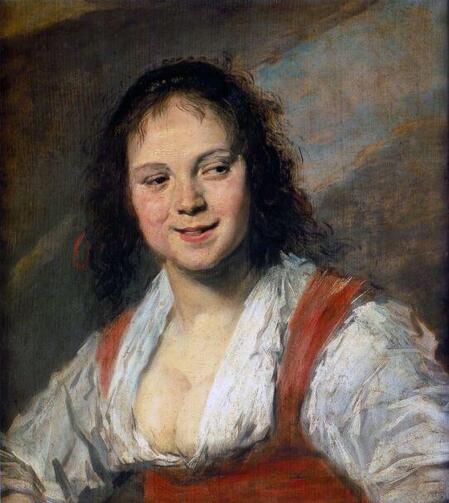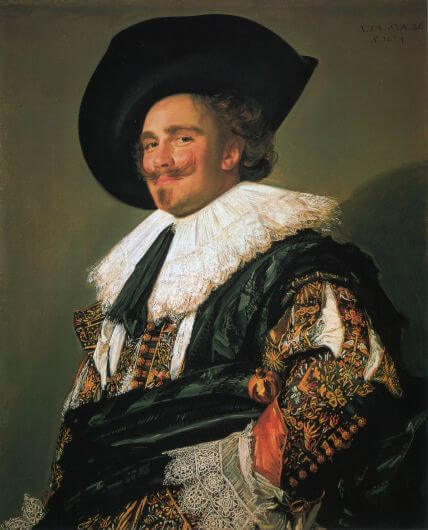|
Where? Gallery 630 of the Metropolitan Museum of Art
When? 1616 Commissioned by? Unknown. Possibly a chamber of rhetoric or it was uncommissioned. What do you see? In the center, a woman dressed in a colorful and carnivalesque embroidered costume raises her right hand. She wears a wreath of laurel on her head and red beads around her neck and arms. Next to her are two comical characters. Six other characters surround the three central figures. Frans Hals painted these surrounding people very loosely. The people celebrate Shrovetide, a kind of Mardi Gras or carnival, in the days before Lent starts. To the left of the woman (from our point of view) is an older man grabbing her shoulder. He tries to say something to her. This man is called Peeckelhaering (which means pickled herring), and he can be recognized by two herrings hanging on a cord around his neck (see the two herrings next to the lower arm of the woman). Other items hanging on this cord are sausages, beans, a mussel, broken eggs, and a pig foot. In his right hand, he holds a foxtail. On the right is a man with a red cap looking at the woman in the center. He makes a sexual gesture with his hands. The table in the foreground contains various items, including a bowl with fish, an open can, half a loaf of bread, and deflated bagpipes. Backstory: This painting is also known as “Shrovetide Revellers.” Frans Hals probably depicts a play performed for Carnival. All actors in this play were men, and so the woman in the center is probably a man dressed up as a woman. She wears a wig and makeup. However, her hands are smaller than the hands of the men next to her. This feature either indicates that the man was built in a way that made it easy for him to dress up like a woman, or that she is a woman after all. Hals got inspiration for this painting from the works of Flemish artists like Rubens, Jordaens, and Jan Brueghel the Elder. He had seen their works earlier in 1616 during his 3-month visit to Antwerp. He took the modern Flemish ideas of a very busy composition and colorful figures and applied these to this painting. Hals painted the figures in the background using broad and loose brush strokes. Hals illustrates his trademark brushstrokes perfectly in the painting The Gypsy Girl in the Louvre, which he painted between 1626 and 1628. In 1907, Merrymakers at Shrovetide was bought for 89 thousand dollars by the American art collector Benjamin Altman. He left it for the Metropolitan Museum of Art after his death in 1913.
Symbolism: The two characters next to the woman in the center are two comical characters that played roles in the Baroque theater during that day. The man on the left (from our point of view) is Peeckelhaering. In his right hand, he has a foxtail, the symbol of a fool. A string with items hangs around his neck.
The man on the right is Hans Wurst. He makes an obscene gesture with his hands to the woman. Some of the items on the table are also sexual references. For example, the deflated bagpipes are another reference to the limited sexual potential of Peeckelhaering. What is Shrovetide? The Christian period of preparation for the six-week Lent. This period is strongly associated with Carnival. Shrovetide begins on the Septuagesima Sunday, the ninth Sunday before Easter. It lasts for 2.5 weeks and ends on Shrove Tuesday. The day after Shrove Tuesday is Ash Wednesday, the first day of Lent. Shrove Tuesday is a day with two different faces. Some people use this day to self-reflect and figure out what sins they regret and how they can grow spiritually. Other people celebrate this day wildly, as it is the last day on which they can indulge in food and drinks.
Who is Hals? Frans Hals the Elder was a Baroque painter. He was born in Antwerp, Belgium, by the end of 1582 (or early 1583). At a young age, his family moved to Haarlem, The Netherlands, where Frans would spend the rest of his life.
During the year that Hals painted Merrymakers at Shrovetide, he also became a member of a local chamber of rhetoric called ‘De Wyngaertrancken’ (the vine tendrils). He did not participate in the performances of this chamber of rhetoric as he was a “second member,” which means that he merely admired the performances of other members. It shows his interests in depicting these plays even though his real specialty were the portraits that he painted. Among his most famous portraits are the Portrait of Tieleman Roosterman in the Cleveland Museum of Art and The Laughing Cavalier in the Wallace Collection in London.
Fun fact: Hans Wurst, the man on the right of the woman (from our point of view), was a comical character in 17th-century performances. Hans Wurst means John Sausage, and he can be recognized by the sausage dangling from his cap. He waved this sausage in front of his fellow players to make fun of them. Hans Wurst makes an obscene gesture. He puts the thumb of his left hand in between the middle and ring finger of his right hand, which form a circle. This is a gesture suggesting to penetrate the woman.
Interestingly, this gesture was not visible in the painting when the Metropolitan Museum of Art received it in 1913. Only after they cleaned the painting, the gesture became visible. During this cleaning in 1951, the six figures in the background were also discovered. Interested in a copy for yourself? Poster
Written by Eelco Kappe
References:
0 Comments
Leave a Reply. |
Categories
All
|
- Home
- Blog
-
Museums
- Alte Pinakothek
- Art Institute of Chicago
- Baltimore Museum of Art
- Barber Institute of Fine Arts
- Bargello
- Barnes Foundation
- British Museum
- Church of Sant’Anastasia
- Cleveland Museum of Art
- Courtauld Institute of Art
- Detroit Institute of Arts
- Frans Hals Museum
- Galleria Borghese
- Gallerie dell'Accademia
- Getty Museum
- Guggenheim
- Hermitage Museum
- Kunsthistorisches Museum
- Kunstmuseum Basel
- Legion of Honor Museum
- Louvre
- Mauritshuis
- Metropolitan Museum of Art
- Musee d’Orsay
- Museum of Fine Arts in Boston
- Museum of Modern Art
- National Gallery in London
- National Gallery of Art
- National Museum in Poznań
- Norton Simon Museum
- Ny Carlsberg Glyptotek
- Palace of Versailles
- Palazzo Pitti
- Palazzo Vecchio
- Petit Palais
- Philadelphia Museum of Art
- Prado
- Pushkin Museum
- Ravenna Art Museum
- Rijksmuseum
- San Diego Museum of Art
- Santa Maria delle Grazie
- St. Peter's Basilica
- Städel Museum
- Statens Museum for Kunst
- Tate Britain
- Tate Modern
- Timken Museum of Art
- Uffizi
- Vatican Museums
- Wallace Collection
-
Artists
- Altdorfer
- Anguissola
- Berlin Painter
- Bosch
- Botticelli
- Boucher
- Bronzino
- Bruegel the Elder
- Brunelleschi
- Cabanel
- Caillebotte
- Canova
- Caravaggio
- Carpeaux
- Cezanne
- Cimabue
- David
- Degas
- Delacroix
- De Maria
- Donatello
- El Greco
- Fontana
- Fra Angelico
- Fragonard
- Gauguin
- Gentileschi
- Gericault
- Gonzalez-Torres
- Goya
- Hals
- Hogarth
- Hokusai
- Ingres
- Leonardo da Vinci
- Lippi, Filippo
- Longhi, Barbara
- Lorrain
- Makovsky
- Manet
- Massys
- Matisse
- Merian
- Michelangelo
- Mochi
- Modigliani
- Monet
- Panini
- Parmigianino
- Perugino
- Picasso
- Pisanello
- Raphael
- Rembrandt
- Renoir
- Reynolds
- Rivera
- Rodin
- Rubens
- Scultori
- Seurat
- Steen
- Tintoretto
- Titian
- Toulouse-Lautrec
- Turner
- Uccello
- Van der Weyden
- Van Dyck
- Van Eyck
- Van Gogh
- Van Hemessen
- Vasari
- Velazquez
- Vermeer
- Veronese
- Vigée Le Brun
-
Locations
- Books
- About Us





